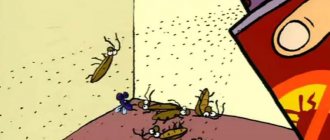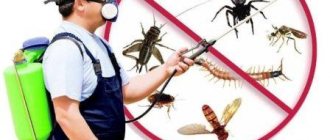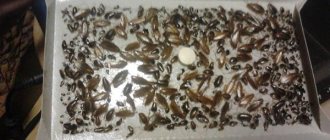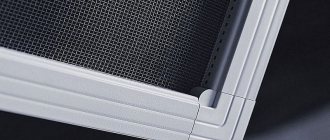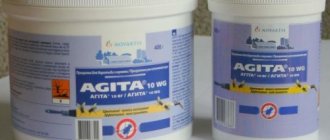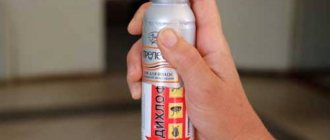Getting rid of flies with vodka
The alcohol smell is extremely unpleasant for flies and most other insects. Therefore, if the aroma of alcohol does not cause discomfort to you, we quickly get rid of flies with vodka.
You can also use regular alcohol by diluting it with water. The liquid just needs to be sprayed into the room using a spray bottle.
But, the effect will be temporary. Once the smell of alcohol wears off, pests may reappear if mosquito nets are not used.
Life cycle and features
Flies are insects with complete metamorphosis. This means that the reproduction and development of a fly goes through several stages, namely egg, larva, pupa, and adult. All stages of the life cycle differ in habitat, feeding method and morphology.
Reproduction of flies (meat flies, house flies and others) begins from the moment of mating of individuals at the adult stage. Males attract females using sound signals they make with their halteres. Fertilization occurs inside the female's body.
On average, after 2 days the female lays up to 200 eggs and is again ready to mate. If all the eggs of one fly survived, then during her entire life, which lasts up to 2 months, the female would give birth to 3 thousand offspring. This is 8-9 generations, which would increase the number of descendants of the first fly to 5 trillion individuals. This is the amazing rate of reproduction of flies.
The full cycle of transformations from egg to adult in flies takes 10-20 days and depends on temperature.
Getting rid of flies with essential oils
Many essential oils also have negative effects on flies. The most effective esters are:
- eucalyptus;
- citrus;
- lavender;
- peppermint;
- carnation.
The product should be diluted with water and sprayed indoors.
Getting rid of flies using bay leaves
The aroma of bay leaves is extremely unpleasant for flies. This is also an effective method to get rid of flies in flower pots.
You can use dry or fresh bay leaf. Just place the leaves in different places in the room so that they do not cause you discomfort with their presence.
Bay leaves also cope well with small midges. If you only need to get rid of flies in flower pots, simply place a leaf on the soil in each pot.
Getting rid of flies with lavender
Lavender has a rather pleasant aroma, but flies cannot tolerate it. The ideal solution is to grow lavender in pots. One pot per room is enough.
If this is not possible, or you do not like indoor plants, use cut or dry lavender, it will also have an effect.
What does a fly larvae farm look like? What do they do with them?
The AgriProtein farm has been raising fly larvae for five years. It is located in the Republic of South Africa in the city of Cape Town. Trucks with organic waste come here from all nearby settlements, which are then turned into excellent animal feed and compost. The main workers on the farm are the black soldier fly larvae. They are the ones who process waste and then become a valuable source of protein.
The black soldier fly is native to America, but spread widely in the 20th century. She is friendly and does not suffer from illness. Adults do not have a mouth. Therefore, the flies do not feed and die immediately after they leave their offspring.
Strong strains were selected for the farm. It's like breeding stock in livestock farming. Insects are kept in ideal conditions. All parameters are taken into account, from temperature to light wavelength. Natural light cycles are observed, including dawn and dusk. The imitation of natural conditions is regulated by digital control. All the nuances were developed by engineers together with entomologists.
Every cubic meter is used rationally. Employees monitor egg production. The most fertile females and males are regularly selected. The eggs turn into voracious faces. These babies increase their weight 200 times in just 10 days. As at any agricultural enterprise, they monitor the health of their wards and calculate the feed allowance.
Once the larvae have reached their maximum size, they produce a feed additive for farm animals. The larvae are edible and very nutritious, containing a lot of protein. After drying and grinding, they turn into protein flour. The product is added to feed. There are developments that make it possible to shorten the cycle and remove the extra link – animals. Scientists propose selling the larvae as food to humans. The production of alternative protein will reduce the cost of food and have a positive impact on the environment.
The second focus of the farm is compost enrichment. The larval residue is added to the humus and nutritious soil for plants is obtained. The soil is enriched with nitrogen, calcium and magnesium.
AgriProtein plans to open production in California. The launch is scheduled for mid-2021. International expansion and opening of farms in the Netherlands and Belgium are being discussed. Farms of other companies that breed insects are already operating in Holland, the USA and Canada.
, we work for you
Getting rid of flies with mint
Mint also has a strong aroma. It is usually pleasant to humans, but intolerable to flies. Mint will also repel pesky rodents.
Simply place mint leaves in different places in the room. You can also use dried mint flowers.
Getting rid of flies with cloves
Another option for getting rid of flies in an apartment is to use clove branches. It is enough to place them in different places in each room.
The branches of the plant are quite beautiful, so they will look appropriate in vases, and at the same time repel annoying flies.
Dried clove buds can be combined with lemon.
Bark beetles in a wooden house - a description of how to get rid of the borer beetle. Tips on how to permanently remove dangerous parasites (105 photos)- How to get rid of bedbugs - tips on how to remove dangerous parasites from a house or apartment (115 photos and videos)
Cockroach trap: review of the simplest and most effective methods of catching cockroaches (125 photos)
Cut the citrus fruit into 2 parts and insert the plant buds into the halves. The scents of lemon and clove will mingle, effectively repelling flies.
Getting rid of flies with basil
Basil is not only a culinary spice, but also an effective fly repellent. The advantage of the plant is that it can be grown at home in trays.
Basil is not picky about growing conditions. Dried basil leaves also have a fly repellent effect.
Dried basil can be packaged in small bags. Place them in all rooms. The odors produced effectively repel flies and create a pleasant aromatic atmosphere in the room.
Growing technology
Whether you grow larvae for yourself at home or in a large production facility for sale, the technology is the same.
It differs only in the size of the premises, the amount of raw materials and the containers used. Larval production can be divided into several stages:
- Fresh or rotting organic matter is placed in the container. The container itself is placed in a cool, shaded room accessible to the blue blowfly. Other types of flies have smaller larvae.
- After a couple of days, the flies lay eggs in groups on the product.
- The container is closed with a lid with small holes made for air access.
- The larvae begin to grow, and when they reach the desired “marketable” size, they are transferred to sawdust to remove the unpleasant odor.
- After two days, the maggots are transferred again and stored. Keep the larvae at home in the refrigerator. If you miss the moment of moving them to a cold place, the larvae will pupate.
Getting rid of flies with wormwood
An effective method to get rid of flies in the house is to use wormwood. The plant has a fairly strong aroma.
However, keep in mind that the smell may be unpleasant for people. Therefore, you should first try to spread a small amount of the plant.
- Remedies for bedbugs: modern methods and tips on how to effectively remove bedbugs (110 photos + video)
How to make a mousetrap: rating of the best models and tips on how to catch a mouse with your own hands (115 photos and videos)
How to get ants out of the house - reasons, methods and recommendations on how to get rid of them once and for all (100 photos)
The pungent aroma of wormwood effectively repels flies. The plant is also extremely effective against a host of other types of insects.
Getting rid of flies with geranium
Geranium is an extremely useful plant that can be grown indoors. It has a pleasant appearance and aroma, and at the same time effectively repels insects.
Geranium allows you to get rid of both flies and most other insects, including small midges.
In addition, geranium has a strong antiviral effect. The plant purifies the air in the house, which has a positive effect on the well-being of household members.
Devices for growing fly larvae and separating them from processed substrate
4. Equipment for growing maggots (fly larvae) and separating them from the processed substrate.
Fly larvae are grown in a special device - an incubator, the design of which plays an important role in their development.
An incubator for growing fly larvae should be easy to use and have high productivity with a small footprint.
The growing device includes several cultivator trays that are inserted into one frame. The size and number of trays must correspond to the daily output of bird droppings. A mandatory requirement is that the height of the sides of the tray must be at least 17 cm. Such cultivators are easy to use, easy to transport, compact and productive.
After cleaning the poultry houses, fresh bird droppings from the cesspools enter the first zone - the substrate enrichment zone. In special mixing containers, malt sprouts or sawdust with blood, or sugar pulp, or simply small sawdust of any tree species are added to the bird droppings in an amount of 10%.
After mixing, the entire resulting substrate is loaded into cultivator trays, small fly larvae hatched from eggs are placed in the substrate, and then the trays are inserted into the nursery container.
The next zone is the zone for receiving housefly eggs. This room houses an insectarium for keeping fetal females of a laboratory population of flies. They are kept in special cages, which are equipped with light and heat sources and bactericidal irradiators. The insectarium maintains a certain temperature and humidity, the parameters of which should be optimal for the fertility of flies and their vital activity.
Containers for growing larvae consist of several cultivator trays. The frame of each container is made of metal, the wall is made of plastic or wood. Cultivator trays have a horizontal design and are made of galvanized sheet or other chemically resistant material.
A fresh air supply is supplied to the bottom of each incubator. And in its upper part an exhaust pipe is installed. Each exhaust pipe connects to form the main exhaust pipe at the end of which a biofilter is installed. Through the exhaust pipe, accumulated gases as a result of thermophilic processes occurring in bird droppings are constantly removed.
After installing the cultivator trays, the container is hermetically sealed and rolled into the larvae rearing area, where they are connected to the ventilation duct. In this zone, the air temperature is constantly maintained at +30 °C, and fresh ventilation air is supplied to each container at a temperature of (+28 – +30) °C.
In this device, maggots are grown in horizontal cultivator trays, and their separation from the processed substrate is ensured by the action of high temperatures on the fly larvae. Tray cultivators have different sizes. Although each tray is the same length, their width is different. Along the entire length, all sides of the trays have closed walls. They are installed on the frame of the device so that the width of the trays increases from bottom to top.
The bottom of each tray is equipped with a heat source. A thermostat is installed on the frame frame, which is configured so that the heat source heats the substrate gradually, slowly over 45 minutes and at the end of this time a temperature is created in the range of +45 - +52 ° C, at which the separation of the larvae from the substrate will be complete.
This mode of operation not only contributes to a more complete separation of fly larvae from the processed substrate, but also the costs for the technological process of separating the larvae and obtaining biomass will be the lowest in comparison with other known methods.
Studies have shown that when maintaining optimal temperature and humidity of the substrate, the development of larvae ends within 3.1 - 3.4 days. After this period, the container with mature fly larvae, already separated from the substrate, is rolled into the next zone - the zone for removing the larvae and packaging fertilizers. Fertilizers are transported to the warehouse, and the larvae are placed in the drying zone or placed for pupation, or in refrigeration units.
source
Bottle trap
Cut off the neck of the bottle and insert it into the middle of the bottle with the reverse side. Inside you need to add water and some sweet substance - sugar, honey, jam. You can pour sweet soda or beer. Sweetness attracts flies.
How to get rid of small midges - how to get rid of them once and for all at home (85 photos)- How to get rid of fruit flies - where do they come from and tips on how to quickly and easily get rid of fruit flies at home (105 photos)
Flies in the apartment: effective methods and recommendations on how to get rid of flies (110 photos and videos)
The neck of the bottle will allow flies to get inside the bottle. However, due to the narrow passage, they are unable to get back out.
After filling the trap with insects, add a small amount of vinegar to it. The acidic smell will poison the insects, causing them to die. It is better to throw away the trap after use.
Construction of a growing container
How to grow maggots so that they have less contact with unpleasant odors and sticky substrate? Many fishermen easily solved this problem by constructing special maggots that can be used at home. They are easy to make at home with your own hands. And breeding larvae in them does not require frequent human intervention.
The maggot trap consists of three containers placed one on top of the other.
- The upper container is used for storing meat or fish. It has a holey lid and the same bottom.
- The middle container also has a holey bottom; wood shavings or large sawdust are placed in it in a layer of 5-7 centimeters.
- The lower container is used for clean maggots; sawdust is poured into it.
This design works like this:
- We put the meat in the upper container and place it in a shaded place where flies can find the meat.
- After two or three days we check, and if we see that the flies have laid eggs, we cover the top of the structure with a lid and put it in place.
- The hatched maggots grow and, having reached a marketable size, tend to pupate. They fall down and penetrate through the holes into the middle container.
- Having passed through a layer of sawdust or shavings, they are cleaned and fall into the lower vessel, and from there they are removed and packaged in jars that are taken fishing.
The entire production of maggots takes from a week to ten days, depending on the air temperature and the speed at which the blowfly lays its eggs on the prepared substrate.
Getting rid of onion flies
Flies are often caused by bulbous plants. This is due to the fact that the bulbs are infected with fly larvae.
Folk remedies such as tobacco dust, ash, ammonia, tincture of tomato tops, etc., are usually ineffective against such flies.
Spicy plants with a strong smell, for example, marigolds or chervil, should be planted next to bulbous flowers.
If there are too many onion flies, these remedies may also be ineffective.
In this situation, the only effective way to get rid of onion flies is the use of insecticides. The most popular include Aktaru, Biotlin Bau, Confidor Extra and the like.
Plants need to be treated twice, during fly periods. It is important not only to repel flies, but also to get rid of larvae, which insecticidal preparations do well.
Viviparous species
These representatives are characterized by rather low “productivity” due to the greater protection of the larvae. The Wohlfarth fly is a viviparous species found in Europe. In Africa, this species is the tsetse.
The developmental stage from egg to larva takes place latently in the abdomen of the female. Flies lay larvae that are ready for independent life. In tsetse they immediately burrow into the soil and pupate. In Wohlfarthova, the maggot parasitizes living organisms. Once on the body of an animal or person, the larva bites into soft tissue. It spends all three larval phases under the skin of the host. To pupate, it climbs out and buries itself in the ground.
Photo tips on how to get rid of flies
Read here How to get rid of bedbugs - tips on how to remove dangerous parasites from a house or apartment (115 photos and videos)
Did you like the article? Share 
0
